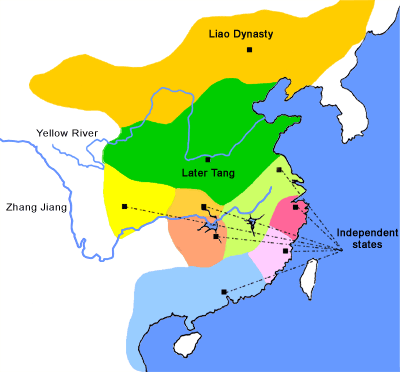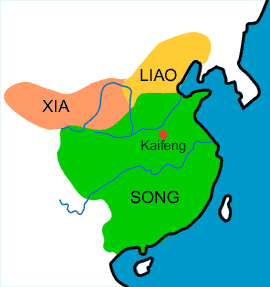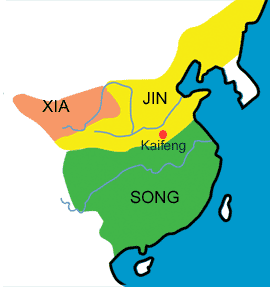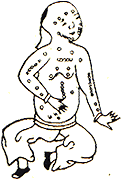Five Dynasties 907 - 960 AD
| * |
|
Later Liang |
907-923 AD |
| * |
|
Later Tang |
923-936 AD |
| * |
|
Later Jin |
936-946 AD |
| * |
|
Later Han |
947-950 AD |
| * |
|
Later Zhou |
950-960 AD |
With the collapse of the Tang Dynasty, China was ruled by a series of short-lived dynasties originating from Kaifeng. As a result, the country was divided into independent states.
 |
| Territories of China in 930AD |
The Liao Dynasty 916 - 1125 AD
The Liao was a powerful dynasty in the North established by the Khitan people. The Song Dynasty which coexisted with the Liao Dynasty was required to pay huge sums of money to them in order to maintain peaceful relations and prevent invasion.

The Northern and Southern Song Dynasties 960-1279 AD
| * |
|
Northern Song |
960-1127 AD |
| * |
|
Southern Song |
1127-1279 AD |
About the Song Dynasties
Zhao Guangyin reunified China and founded the Song Dynasty in 960 AD. The empire was continually threatened on all sides by invasion from barbarians. Besides problems in the north with the Liao Dynasty, the Song also had to contend with the Tibetans and the Tanguts tribe to the west. Eventually, the threat of invasion became a reality and the Jurchen (an isolated clan originating from the Tanguts tribe) established the Jin Dynasty in the north in 1127 AD. This forced the Song south into Hangzhou where they would remain until the late thirteenth century when the Mongols invaded China.
 |
 |
| Northern Song 960-1127 AD. |
Southern Song 1127-1279 AD. |

A busy market scene in the Song Dynasty. |
Fueled by economic growth from agriculture, an urban bourgeois class emerged. The bourgeois indulged in comforts of daily life and lived extravagantly. Marine trade expanded significantly due to both an increase in commercial trade and the growing difficulty of making overland trips because of the barbarian control of trade routes. Confucianism saw resurgence in this period and was later renamed neo-Confucianism by philosophers. Other new philosophies evolved and these were also applied to medicine. The period was further buffeted by a series of reforms and counter-reforms. The "new laws" of the dynasty introduced by Wang Anshi (1021-1086 AD), a prime minister in Northern Song, are held to have constituted radical political changes in China. The changes facilitated medical reorganization and enabled new healthcare systems or facilities to be set up, these included government dispensaries, hospitals, and charitable institutions.
Publishing Boom of Chinese Medicine Texts
 |
| Woodblock printing |
The use of woodblock printing, although existent since the Tang Dynasty in 868 AD, was further improved by Bi Sheng in 1040 AD with the invention of movable type. This had a significant impact on Chinese medicine and science in general as it enabled important texts to be more easily published and readily disseminated.
During this period, a state institution known as the "Bureau for the Re-editing of Medical Books," was created in order to "collect, collate and verify all medical texts bequeathed by 1,000 years of history.2" This bureau published several of the established classics and many books were rewritten or revised under new titles. Therefore many classics like Huang Di Nei Jing (The Yellow Emperor's Classic of Internal Medicine), Shennong Bencaojing (Classic of Herbal Medicine), Maijing (Pulse Classic or Manual on the Pulses), and Zhenjiu Jiayijing (The ABC of Acupuncture and Moxibustion) etc, have been handed down after being checked and printed. The bureau also produced commentaries on classics such as Huang Di Nei Jing (The Yellow Emperor's Classic of Internal Medicine) and Zhang Zhongjing's Shanghanlun (Treatise on Febrile Diseases).
In addition, many medical texts were published under government supervision or individually. Campaigns were launched by the Song government for gathering information from the public and for the periodic compilation of medical texts. A great deal of original material in the form of pharmacopoeias were written.
Besides pharmacopoeias, many prescription books were also published. The first one, entitled Taiping Shenghuifang (Prescriptions from the Pharmacy of Harmonious Assistance), was commissioned by the government and written by Wang Huaiyin at the end of the tenth century. It lists a total of 16,834 prescriptions and gives details of the prescription, drugs used, syndromes and pathology.
The number and variety of such works testify to the flourishing state of Chinese medicine at the time.

A Chinese peasant being treated by a village doctor with moxibustion. |
Medical Education
During the Song Dynasty, medical administrative duties and medical education were separated. The government's "Board of Medical Officers" was in charge of overseeing the practice of medicine and the delivery of medical care. Wang Anshi an important political figure of the eleventh century initiated sweeping reforms that included developing a more perfect examination system and curriculum in medicine. As a result of his reforms, the Imperial Medical Bureau (taiyiju), which was in charge of medical education, expanded to become the Imperial Medical College. Soon after, a number of medical schools were founded in different cities or towns in China and this extended medical knowledge to a more popular level.
Examinations for medical students were also launched during this period and were set up along similar lines to those for civil servants. Students were promoted to the next level based on their scholastic records and their treatment success rate. The Imperial Medical College was further divided into nine departments:
| 1. |
Internal medicine |
6. |
Dermatology and orthopedics |
| 2. |
Obstetrics |
7. |
Acupuncture and moxibustion |
| 3. |
Pediatrics |
8. |
Trauma and incantations |
| 4. |
Ophthalmology |
9. |
Wind diseases (treating diseases such as stroke) |
| 5. |
Ear, nose, throat and dental |
|
|
|

Wang Weiyi
(987-1067A.D.) |
Besides studying the earlier classics of the Tang Dynasty, medical students would have newly created curricula, such as the "three causes" (sanyin) theory by Chen Yan (see A new teaching section), added by the end of the twelfth century. Students also became more familiar with anatomy as illustrations drawn by the physician/poet Yang Jie (1068-1140 AD) from autopsies of executed prisoners became available.
 |
| Bronze model of acupuncture points |
Another advancement in medical education was the casting of two life-size male bronze statues by Wang Weiyi (987-1067 AD), an officer of the medical board, appointed to summarize the acupuncture classics for teaching acupuncture. These statues had 657 acupuncture points drilled into them which were filled with water and covered with wax. When a student needled the acupuncture point correctly, water would leak out. To complement the statues, Wang Weiyi compiled a book called Tongren Shuxue Zhen Jiu Tujing (Illustrated Manual of the Bronze Man Showing Acupuncture and Moxibustion Points). This work was considered so important that it was carved on two stone steles and these were erected in Kaifeng, the capital of the Northern Song Dynasty, for public use. The bronze statues would contribute significantly to the future education of acupuncturists.
A New Teaching: Theory on the Three Causes
As mentioned, a new approach to etiology was first propounded by the twelfth century physician, Chen Yan. His work Sanyin Jiyi Bingzheng (A Treatise on Pathology) stated that there are three types of pathogenic agents(sanyin): endogenous, exogenous, and those that are neither one nor the other. These influences lead to an imbalance between the yin and yang in the body, between the vital energy (qi) and the blood, or impair functions of organs and meridians, all of which give rise to illness. This principle has been applied by traditional Chinese medicine physicians until today.

Poison victim |
Medical Advances in Forensic Medicine
Xiyuan Jilu or Xiyuanlu (Washing Away the Wrongs) was written by Song Ci in 1247 AD. The book details how to perform autopsies and lists observations about physiology, histology, pathology, pharmacology, and toxicology. According to this book, someone who has been fatally poisoned will present with a green or purplish complexion, the eyes and mouth will be wide open, the nails on the hands and feet will be blue, and blood may trickle from the eyes, mouth, ears, and nose. To confirm that poisoning has taken place, a silver needle that has been scrubbed in soapy water should be stuck into the victim's mouth. If the needle turns a blackish color that cannot be washed off, then poisoning is confirmed. This book helped establish the beginning of forensic medicine in China and would go on to be an important medical work that was translated into at least five different European languages.
 |
| Children and woman of the Song Dynasty |
Pediatricians and Gynecologists
During the Song dynasty, the interest in medicine shown by the Song authorities led not only to official support for the publication of general medical works but also to a new surge in medical studies. Pediatrics and gynecology became a specialized and independent branch of medicine, and obtained significant results.
The most important figure in pediatrics was Qian Yi (1035-1117 AD). His work was recorded by his disciple Yan Xiaozhong in the Xiao'er Yaozheng Zhijue (The Appropriate Way of Recognizing and Treating Infant Maladies.) Moreover, Qian Yi contributed to a better understanding of eruptive fevers, such as smallpox, chickenpox, and measles, in terms both of symptoms and therapies. It dealt entirely with infant medicine, considered under its physiological, pathological and therapeutic aspects.
| |
* |
Other famous pediatricians or texts of the Song dynasty include...... |
The Song Dynasty had developed public welfare in the urban areas with the opening of dispensaries, hospitals, and orphanages. Urbanization obliged the authorities to make special arrangement for public hygiene. In some places during the Southern Song period, road-sweepers and night-soil collectors were a daily presence. Evidence also points to the use of spittoons. Preventive measures against contagious diseases were set up by the government. The common occurrence of smallpox at that time, the cause of a very high infant mortality rate, stimulated studies in the disease.
|
| |
* |
Studies in smallpox during the Song include...... |
The fields of gynecology and obstetrics had begun to take on the hallmarks of an independent branch of medicine. Chen Ziming (c. 1190-1270 AD) produced a work, Furen Daquan Liangfnag (Collection of Gynecology Treatises), which specifically dealt with various gynecological problems associated with menstruation, pregnancy, and childbirth. A whole chapter of his book is devoted to cases of dystocia (difficult childbirth) and several examples are described: shoulder-, face-, and breech-delivery.
|
|

Smallpox in children |
|
Foreign Influences
Due to the remarkable expansion in marine trade, exchange of information between East and West reached a peak at this time. There are records that Arabian merchants shipped over 60 different items of materia medica to European, Asian, and African countries. Included amongst these were cinnabar, ginseng, monkshood, pepper, tuckahoe (Indian bread), and bezoar. Bezoar was regarded as the most valuable and was held important at that time for the prevention of epidemics. The relationship that China enjoyed between the tenth and twelfth centuries with Korea, Japan, South-east Asia, and the Arab world facilitated mutual exchanges in the fields of medicine and pharmacy. Among the items of tribute offered by various states to the Chinese emperor, it is common to find animal, vegetable and mineral products that were to be used in the manufacture of medicine. Such were rhinoceros horn, ivory, rose-water, pearls, coral, and melon. In return, many medical classics or physicians were sent to these states and this greatly influenced their medical development. Nowadays, copies of many ancient classics which have been lost in China can still be found elsewhere in the world.
 |
| Port in the Song Dynasty |
|